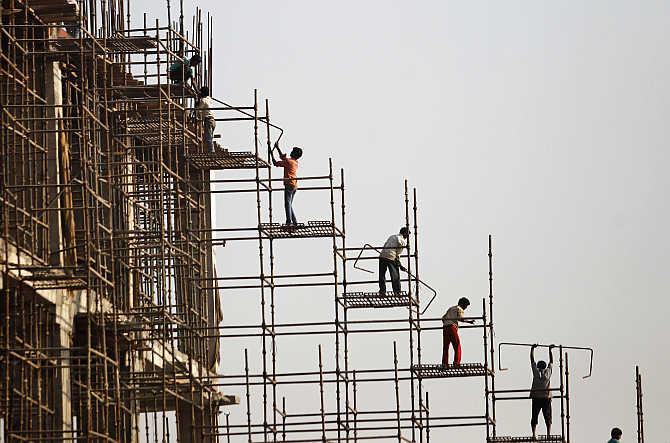Photographs: Rupak De Chowdhuri/Reuters Mansi Taneja
Keeping the organisation lean and mean, using pre-fabricated structures, inking long-term contracts with vendors and ensuring greater use of technology are some of the measures developers such as Tata Housing and Value and Budget Housing Corporation (VBHC) have adopted to make their affordable housing business feasible.
This shift in the business strategy comes at a time when the margins of developers have come down from 30 per cent to 15-20 per cent, according to industry estimates.
Squeezing margins have not deterred Tata Housing from expanding its affordable housing business, which is expected to contribute 30 per cent to the overall revenues.
Started five years ago, Tata Value Homes, a fully-owned subsidiary of Tata Housing, is currently developing 350 acres with a potential to build 23 million sq ft and get revenues of Rs 5,000 crore (Rs 50 billion).
Please click NEXT for more...
Please click here for the Complete Coverage of Budget 2014 -15
How builders are making their low cost housing business viable
Photographs: Reuters
Realty Bites
Margins for developers have fell to 15-20 per cent in affordable segment.
Tata Housing & VBHC have lined up expansion plans for this year.
Affordable housing requires a different business model - from sourcing to distribution and from pricing to margin, says Brotin Banerjee, CEO and managing director of Tata Housing.
"Unlike premium and luxury projects wherein we sell the project in phases to ensure decent returns in the long-term, for value and affordable housing we sell the entire project within a very short span of time and then focus on project management."
"Timely completion of project plays a critical role to be successful in this segment. The idea is to adopt a manufacturing style set up to construct quickly, hand over apartments and move on to the next project."
Tata Housing also prefers to have long-term contracts with vendors to hedge against the rising commodity prices, Banerjee adds.
Please click NEXT for more...
Please click here for the Complete Coverage of Budget 2014 -15
How builders are making their low cost housing business viable
Photographs: Anindito Mukherjee/Reuters
Set up in 2009, VBHC has opted for a lean organisation as most of the work is automated.
The company has an in-house design team, which helps maintain time schedules, thereby saving on costs.
"We have a strong technology backbone. Most of the processes are done online.
Further, we use foam technology wherein we can build a floor in five or six days, which enables us save cost and time," says Rahul Sabharwal, chief operating officer at VBHC.
Even cash flows are tightly managed. "Ours (affordable housing) is like a manufacturing industry. It has always been a tough model but we can still run it profitably," he adds.
Please click NEXT for more...
Please click here for the Complete Coverage of Budget 2014 -15
How builders are making their low cost housing business viable
Photographs: Punit Paranjpe/Reuters
Tata Housing also uses various technologies such as hollow pre-fab, steel reinforced expanded polystyrene concrete panels as load-bearing walls, and use of bio-enzyme for subgrade improvement in internal road construction for faster construction.
It has also set up a pre-cast plant in Bangalore to keep the costs in check.
Over the years, affordable housing has acquired a different meaning. With land prices going through the roof and input costs rising coupled with inflationary pressures, developers are finding it hard to launch affordable projects.
Please click here for the Complete Coverage of Budget 2014 -15






article